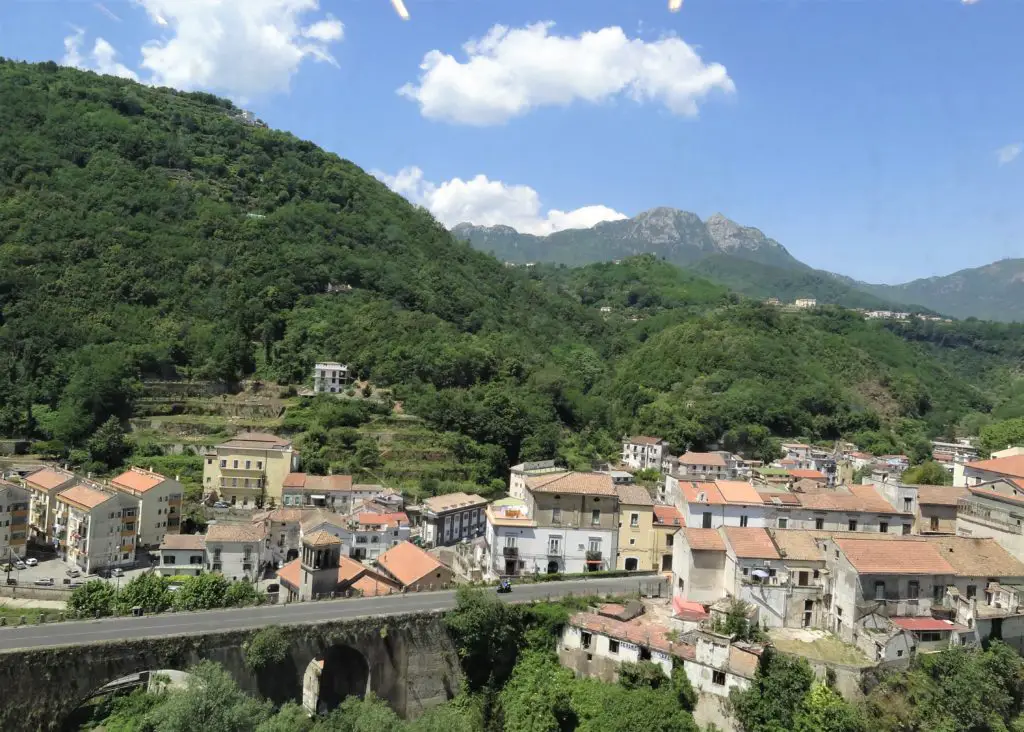Chances are you’ve heard the story of the ancient city of Pompeii. But did you know Pompeii is the world’s largest archaeological site? Or that the city was buried under 20 feet of debris and went undiscovered for 1,500 years? In this guide to visiting Pompeii, I’m sharing interesting facts along with what to see and do. Uncover tips for planning your Pompeii ruins trip. This iconic city is definitely worth a visit!

Today, the Pompeii ruins are visited by millions of people a year.
And let me tell you, it’s definitely worth visiting!
My husband and I honeymooned in Italy. Of all the amazing things we saw on our trip (the Sistine Chapel, the Colosseum, villas in Florence and the charm of Venice), by far visiting Pompeii was one of the best things we did.
In this post I’ll be answering your biggest questions (and sharing 10 great tips) about Pompeii so you can plan your visit. We’ll cover:
- the story of Pompeii
- how to get there
- things to see and do
- how long you need to explore the ruins
- ticket prices
- what to wear
- and more!

The Fascinating Story of Pompeii

If you haven’t heard the story of Pompeii, where have you been??
Just kidding.
And yes, Pompeii is a real place (not just a pop song).
An ancient Italian city, Pompeii was quite the happening place over 2,000 years ago. There were paved streets, a marketplace, an amphitheater, (even brothels). Unfortunately, the people of Pompeii were living next to a dormant volcano.
When it erupted, Mt. Vesuvius sent ash, rock, and scorching gas over the city. It was completely buried and an estimated 12,000 people were killed. While it’s a terribly sad story, it’s also quite fascinating…

For years, the city remained buried. Untouched, shielded from moisture, sunlight, and theft.
Until one day when archaeologists discovered it by accident!
They were shocked to find that the city itself was mostly intact, even though thousands of years had passed. They found numerous artifacts, structures, roads, buildings, and even imprints of people (which were later made into casts).
How To Get To Pompeii
Pompeii is located in southern Italy, and can be reached by train, car or bus. For reference, the closest nearby city is Naples. In general it’s easiest to reach Pompeii from a starting point of Rome or the Amalfi Coast. My recommendation…
Tip #1: Take The Train
It’s a quick 2-hour train ride from either Rome or the Amalfi Coast to Pompeii. On our trip, we traveled from Salerno (a smaller town in southern Italy) and the train ride was BEAUTIFUL.

It’s pretty affordable, comfortable, and you get to see the beautiful countryside on the way there. Still unsure? Read more here to decide on transportation.

How Long Does It Take To Explore?
Now that you know how to get there, the next thing you may be wondering is how long you need to explore the ruins. This will vary somewhat, depending on how busy it is and how thorough you want to be. But here’s a good rule of thumb:
Tip #2: Don’t Rush – Make It A Full-Day Trip
The ruins are massive – over 100 acres in size! And there are so many fascinating things to see. Once you factor in time spent getting there (and getting back), it will likely end up taking the majority of your day. At a minimum I would plan on being there approximately 2-4 hours to explore.

What Can I Expect?
Have you ever wondered how people lived thousands of years ago?
What their life was like…. What they believed in… The daily rituals they went through…
When you visit Pompeii, you really get a sense of what life was like in 79 AD. A few things you see at the ruins are fascinating paintings, pottery, architecture and more. There’s so much to see, and it’s spread out over a very large area. For that reason…
Tip #3: Wear Comfortable Shoes
You’ll be doing lots of walking, so be prepared by wearing comfortable shoes (and clothing!) You’ll be walking on lots of dirt, so it’s very likely that your shoes will get dirty after a day of exploring.
There are some small hills at Pompeii, so be aware of that too. Nothing too steep in my opinion.

How Much Does It Cost?
You do need tickets to visit Pompeii, and they cost 15 Euros (roughly $16.60 US dollars) each. There are some instances where you can get a discounted ticket (journalists, history teachers, etc.) so click here to read more about special circumstances. But otherwise…
Tip #4: Don’t Buy Tickets Outside The Park
You’ll see lots of street vendors, tents, and shops that advertise tickets to Pompeii. But sellers outside main entrances are not associated with Pompeii Archaeological Park management. Keep going and once inside the park, head to the ticket booth. Here’s some more advice for once you’re there:
Tip #5: Buy Tickets Online (Or Bring Cash)
Something really important to know is that the ticket booth doesn’t accept credit cards. So be smart and purchase tickets online ahead of time. As an alternative, just bring cash and you’re good to go.

Should I Take A Tour Of Pompeii?
It’s definitely doable to just buy your tickets and explore on your own. That’s what we did on our trip to Pompeii. But, if you want to hear more of the history of the ruins, or not have to worry about the details of where to go and when, a tour could be a good option.
Still can’t decide? Check out this list of 15 Best Pompeii Tours.
Tip #6: Pick Up A Free Map
In case you do end up exploring on your own, be sure to grab a free map at the information booth. That way you’ll get an overview of where everything is located. Plus, you won’t be wandering aimlessly not knowing what you’re looking at.

Things To See At Pompeii
Because the city is preserved so well, it’s like a sneak peek into ancient Roman life. You can see how the people of Pompeii did their laundry, what their homes looked like, where they socialized. Here are a few interesting things you’ll see on a visit to Pompeii:

There’s even ancient theaters and a gym! Not to mention several temples, an amphitheater, and even tombs.
You can even see the oldest Roman amphitheater still standing. It’s truly a wonder of ancient architecture, the amphitheater at Pompeii can hold over 12,000 people! This is where gladiator battles, shows, and other types of entertainment happened in the city.

Unfortunately, not everyone from Pompeii were able to flee the city before the volcano erupted. The bodies of those left behind were encased in ash and pumice, which preserved them over the years.
When the city was discovered, they basically found imprints in the ground which were later made into casts. You’ll see several of these on your visit:
Once you’re at Pompeii (and have your map), here are some other really cool things you can see:
- The Forum Baths (this was one of my favorites!)
- The Forum (the center of the city)
- House of the Faun (biggest house in Pompeii)
- Garden of the Fugitives (if you want to see multiple preserved bodies)
- The Amphitheater (where they had gladiator matches and other events)
- The Great Palestra (basically an outdoor gymnasium of sorts)

Want more specifics? Here are a few great resources for all the things you can see while visiting Pompeii:
- The Ultimate Guide To Visiting Pompeii
- 14 Things To See In Pompeii
- Cool and Unusual Things To Do In Pompeii
What Should I Wear?
Weather in Pompeii is pretty mild. The coldest month is January with an average high of 57 degrees and low of 42 degrees. In the peak of summer the temperature averages 70-88 degrees. With that being said, there are a few things you’ll want to keep in mind, no matter what time of year you visit Pompeii:
Tip #7: Wear Sunscreen And A Hat
Have you ever gotten sunburned on vacation before? It’s no fun. There’s minimal shade at Pompeii (unless of course, it’s an overcast day). And knowing that you’ll be there for several hours (and mostly outdoors), be prepared with sun protection.

What Can I Bring To Pompeii?
Before you go, it’s good to know what you can and can’t bring inside. Here are a few things to avoid bringing to Pompeii:
- professional optical and audio equipment
- big dogs (read more about pets)
- bikes or scooters
- large backpacks, bags or luggage
- umbrellas
- masks or costumes
- drones
Tip #8: Travel Light
Large bags aren’t allowed, but that doesn’t mean you can’t have a small purse or backpack with you. The allowed size is 30 x 30 x 15 cm. Just bring the essentials (sunscreen, a hat, water, camera, phone, money, identification) and you’ll be just fine.

Eating At Pompeii
There’s a small cafeteria inside the park, but they have limited options. My recommendation is to bring a snack or eat beforehand. A visit to Pompeii isn’t something you want to do on an empty stomach! You’ll be mostly outdoors, in the sun, and doing lots of walking so plan accordingly.
Tip #9: Bring Snacks For The Train Ride
To maximize time, we ended up stopping at a local grocery store to pick up some snacks to eat on the train ride. It’s also common in Italy for trains to have snacks for purchase – you may see an attendant that comes around with a cart selling food and drinks.

And One Last Thing…
A trip to Pompeii is a once-in-a-lifetime kind of thing. I hope this guide gave you a sense of how epic a place it really is. Pictures don’t do it justice.
But with that being said:
Tip #10: Take Lots of Pictures
You’ll be so glad you did. The trip itself with be amazing, and the photos will be a way to relive the memories again and again. Don’t forget to bring your camera (or smartphone camera), have it charged, and capture the moment.

Ready To Go Back In Time?
Are you ready to visit Pompeii? I hope you enjoyed this guide to the ruins and all the tips I shared! Here they are again, one more time:
- Take the train
- Don’t rush – make it a full day trip
- Wear comfortable shoes
- Don’t buy tickets outside the park
- Buy tickets online (or bring cash)
- Pick up a free map
- Wear sunscreen and a hat
- Travel light
- Bring snacks
- Take lots of pictures






